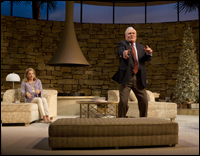
*
Ask Playbill.com answers your (and sometimes our own) theatre-related questions. To ask a question, email [email protected]. Please specify how you would like your name displayed and please include the city in which you live.
Question: In Jon Robin Baitz's Other Desert Cities on Broadway, I was struck by the scenic metaphor of the tiny flame that flickers in the living-room fireplace on designer John Lee Beatty's set. It reminds me of the Eternal Flame that's on John F. Kennedy's grave. Considering the play is about a lost son in a politically-connected family, I wondered how this image came about in the production — is it in the script, was it the idea of the designer or did director Joe Mantello come up with it? — V. Smith, Sewell, NJ
Other Desert Cities, which premiered to acclaim at Lincoln Center Theater's Off-Broadway Newhouse Theater in spring 2011, transferred to the Broadway stage last fall. The drama's characters are all members of the Wyeth clan, the parents of which are politically well-connected within the Republican Party. Prodigal daughter Brooke Wyeth returns home to Palm Springs for Christmas after a six-year absence. She arrives with a bombshell in hand: the manuscript of a memoir she plans to publish, much of it dwelling on her brother, a political radical who disappeared years ago.
John Lee Beatty's posh, polished contemporary ranch-home set was widely praised in reviews as aptly capturing the lifestyle of the elder Wyeths. The New York Times described "the desert-toned, tastelessly tasteful digs of Lyman and Polly Wyeth" as "spot-on." Central to the living room is a modern fireplace, a trumpet-like metal flue hovering over a round base. It is here the "eternal flame" flickers.
| |
 |
|
| Stockard Channing and Stacy Keach | ||
| Photo by Joan Marcus |
"Although I appreciate that the audience member recognized that in both cases it is a flame in a '60s architectural context, it was part of the original script," Beatty said in an email. "Director Joe Mantello and I were referencing classic '60s Palm Springs architecture. What V. Smith might have acknowledged is how very, very rare it is to see actual flame on a Broadway stage. This was accomplished by the new smokeless fuel technology, Stacy Keach piling on logs that are actually fireproof, and a lot of collaborative effort by the designer, the prop person, the production manager and the fire department."
So, no greater message in that flame — except in the eyes of some playgoers, who, in decoding what they see, get a richer experience. Officially, though, the creators were seeking clean design and a proper way to execute it without burning down the Booth Theatre.
View video highlights from Other Desert Cities:









